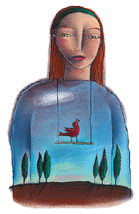

Want to daydream your asthma away? A revolutionary technique for healing asthma offers an alternative spin.
By Maureen Bogues

Asthmatics can breathe a little easier, at least that's what a new book says.
Kathryn Shafer, Ph.D., co-author of Asthma Free in 21 Days: The Breakthrough Mindbody Healing Program, advises people to seek out a more holistic approach to their asthma treatment. By employing the imagination to think about illness instead of relying on pure science, people with asthma can heal themselves more fully than by medicine alone.
"All you're doing is stabilizing (asthma), you're not doing anything about the mind and that's where healing takes place," said Shafer. "It's about taking responsibility, going into the illness and not being afraid of what the body is trying to tell you."
Engaging the spirit
Asthma Free asks people with asthma to engage mind, body and spirit in healing — to think about the emotional, physical and psychological issues that might lead to restricted breathing — and then use a series of relaxation exercises to imagine them being whisked away.
One exercise in the book encourages the patient to imagine her lungs as a pair of golden bellows, breathing in white light as the chest expands, and exhaling impure, gray air into the atmosphere.
Other exercises allow users to create their own personal vision. Take Cheryl, for example, one of the people profiled in the book. In her imagery, Cheryl saw asthma as an anvil on her chest. She then envisioned a band of angels lifting it, and allowing her to breathe. In subsequent visualizations, the anvil took on a familiar face — that of her mother — and she was able to more closely examine how that relationship had hindered her.
With images, said Shafer and co-author Fran Greenfield, "thoughts, beliefs and feelings are mirrored back to you, and the nature of your illness or difficulty takes on a unique visual form."
That is the essence of mind-body medicine: the use of visualizations to make illness less abstract, and engage the mind in an active program of healing.
Getting personal
For Shafer and Greenfield, asthma was not just a chronic illness to be studied and written about, it was a personal battle.
An asthma sufferer since childhood, Shafer had been on medications and inhalers all her life. She had tried many other avenues to healing — including counseling, homeopathy, meditation, nutrition and exercise. But it wasn't until she came upon a book called Healing Visualizations, by Gerald N. Epstein, M.D., that she tried visual imagery. After just three weeks of working with Dr. Epstein, Shafer had given up the inhaler, and within six months, was asthma-free.
In 1996, Shafer was able to complete the New York marathon without using medications after years of hearing many doctors tell her she would never be able to run.
Asthma Free chronicles Shafer's story as well as the stories of clients who attended her workshops across the country. It has more than 40 exercises and visualizations for immediate relief, plus three different 21-day plans for readers to tailor to their own lives.
Greenfield also had intense personal interest.
"I was drawn to asthma because it has so many far-reaching implications," said Greenfield, a mind-body therapist in New York. "For me, breath is life, our way to bring in the spirit world on a deeper level. (The presence of) asthma indicates a break in living and a break in faith."
Asthma on the mind
For physicians across the country, however, asthma is not just psychological, it is a tangible physical ailment affecting 17 million people nationwide.
Dr. Harold Nelson, a senior staff physician at the National Jewish Medical and Research Center in Denver, Colo. said that modern medicine has dispelled the notion of asthma as a psychological disease.
"I think there's no question that if people have asthma, psychological stress makes it worse, but it's not a psychological disease. It's an interplay of genetics and environment producing inflammation of the airways," he said.
He believes that natural medicine can be helpful, but is hesitant to endorse it as a replacement for traditional treatment.
"We don't embrace it, but we tolerate it," he said. "With alternative medicine comes the implication that it has not been subjected to scientific scrutiny and controlled studies. If it's proven effective, it becomes part of mainstream medicine."
Greenfield and Shafer, however, point to a 1997 study by Dr. Epstein which compared an asthma control group using no imagery with asthma patients who did use imagery. It showed that 47 percent of the asthmatics in the imagery group significantly decreased or discontinued medication without compromising pulmonary function.
The body knows best
Greenfield and Shafer want people to search in themselves and decide what is best for their own bodies. If it means taking the medicine as usual, they're all for it. The book is aimed, though, at people who seek an alternative to the status quo, and therefore may be more open to its less traditional program.
And change should be fun, or as Shafer and Greenfield put it, F.U.N. Their approach asks people to: Focus on the asthma in a new way, Undo old patterns of thought and behavior and Now act to transform life situations that repress or suffocate.
"What I find, is that it's so simple," said Shafer. "It's not voodoo."
Maureen Bogues is a San Francisco-based freelance writer and editor. She can be reached at jstsaymo3@aol.com
Copyright © 2000-2025 savvyHEALTH.com. All rights reserved.
http://www.savvyHEALTH.com/
All contents copyright © 1999-2025 savvyHEALTH, Inc. All rights reserved.
This internet site provides information of a general nature and is
designed for educational purposes only. If you have any concerns about
your own health, you should always consult
with a physician or other healthcare professional. Please review the Terms of Use before using this site. Your use of the site indicates your agreement to be bound by the Terms of Use.